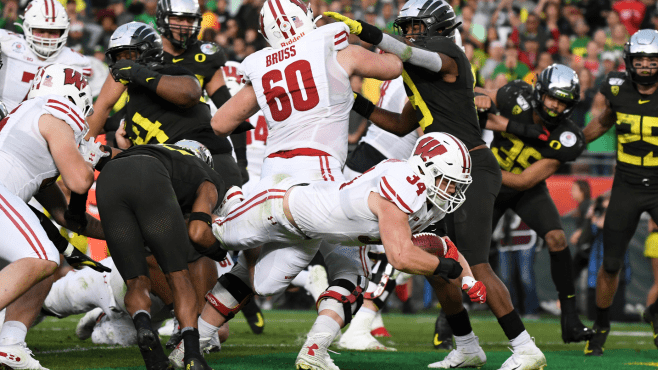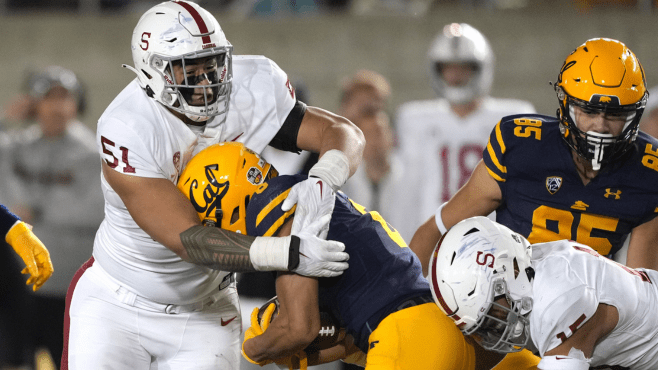
The Conference of Champions has been eviscerated.
The Pac-12 — and before then the Pac-8 — once showcased star quarterbacks like Jim Plunkett, Dan Fouts, John Elway, Warren Moon, Troy Aikman, and Andrew Luck, to name a few. Not to mention, it was also the home of Marcus Allen, Ronnie Lott, Reggie Bush, Tony Gonzales, and Tedy Bruschi, and coaches roamed the sidelines with names like McKay, Walsh, and Carroll.
Yet, a conference with 120-plus years of storied history and 13 Heisman Trophy winners is in a death spiral. Why? Incompetent leadership and the never-ending pursuit of television revenue.
A year, after the Big 10 opted to break its short-lived “alliance” with the Pac-12 and welcomed the University of Southern California and UCLA, the midwest-based conference, opted to add two more — University of Washington and Oregon, which of course is bankrolled by Nike founder Phil Knight.
Rutgers began playing football in 1869 — the sport’s first-ever game — while Oregon played its first back in 1894. The two teams that had never played each other for more than 125 years will now be in the same conference.
By the way, Eugene, Oregon is closer to Russia than it is to the home state of Tony Soprano.
This latest savage poaching came days after the Big 12 — rising from the ashes of realignment like a phoenix — lured Colorado back to the conference after a not-so-glorious run in the Pac-12, and then added the four corner schools of Arizona, Arizona State, and Utah.
The Pac-12 now stands with only four members (Stanford, California, Washington State, and Oregon State) heading into the 2024 season.
The ACC saw the Big 10’s latest amphetamine-induced geography logic and said hold my beer.
The ACC is flirting with the idea of adding Stanford and Cal, all the while one of its marquee programs — Florida State — is openly saying it is open for realignment business. Yes, the Atlantic Coast Conference is trying to add two teams from the Pacific Coast.
This realignment logic reminded me of my college days. It was in geography class when a classmate of mine confidently asked our professor the following question: “Does the equator move around and stuff?”
My reaction was one of shock, as was the professor who was a tad befuddled before politely answering the inquiry. I mumbled something far less polite.
I wonder if my classmate helped orchestrate the latest round of college cannibalism.

The Pac-12’s leadership and its zeal for greed have to be culpable here. The conference could have added members back in 2021 but UCLA and USC voted against it — a year before they bolted for the Big 10.
There was the lackluster and desperate $23 million broadcast deal with Apple TV that proved to be the nail in the coffin, as teams started jumping ship. This shouldn’t be surprising considering the conference rejected ESPN’s $30 million deal back in 2022. They reportedly wanted $50 million per year.
It feels reminiscent of when the Big East was destroyed more than a decade ago, but that was different. That was a basketball conference that tried but ultimately failed to become a football conference.
The Big East leadership pursued more money and it proved to be disastrous. The Pac-12 followed suit.
That Gordon Geeko-like pursuit of greed while also making sure to not be left behind is what is at the root of the latest realignment. This is why Stanford with its 120-plus wins and four Heisman runner-ups in the last 15 years is searching for a home.
The Big 10 responded to the Southeastern Conference’s expansion to 16 teams by adding Texas and Oklahoma by gobbling up programs like a meth addict locked in a pharmacy. It is insane.
Let’s look past the humorous fact that the Big 10 will have 18 teams in 2024 and that expanding its footprint beyond the Midwest is cringeworthy. The same could be said when the SEC added Missouri in 2011, a program located west of the Mississippi but in the SEC East. Once again, geography is hard for some.
The pursuit of cold hard cash is what drives this.
The Big 10 is in a TV revenue race with the SEC and the two are battling to own the sport — which will eventually see them and whatever conference is left standing to create a super league that will separate from the NCAA altogether. That will happen.
Do you think there is a way that the Big 10 and SEC can figure out to get more than the $80 million each Power 5 conference gets off the top of the $720 million annual CFP payout that they won’t? Of course, they will.
This all comes at the expense of rivalries.
Forget the Civil War or the Apple Cup, those beloved regional rivalries by older fans are the collateral damage of conference realignment.
It already has happened before.
When Missouri left for the SEC it left behind the Border War with Kansas, and when Texas A&M left behind — it thought — its annual game with Texas, a rivalry that went through both the Southwest and then Big 12 conferences.
Oklahoma and Oklahoma State’s legendary Bedlam series will soon go away and will become a distant memory like The Backyard Brawl between Pitt and West Virginia.

Can the Pac-12 somehow survive, akin to how the Big 12 resurrected itself after being raided twice by making shrewd moves of adding three highly-regarded Group of Five programs Central Florida, Cincinnati, and Houston, and one independent with name recognition in BYU?
Maybe the Pac-12 leftovers can merge with the Mountain West and create a new West Coast conference, but it likely won’t be as strong as it was before.
The entire realignment nonsense begs a question. Why not have the teams from the three or four strongest Power 5 conferences depart the NCAA and create their league and play for their national championship?
Everyone left can play for its NCAA-attached title and all the other sports — which no one cares about — can remain in the NCAA. That likely won’t happen.
Instead, the NCAA will allow the realignment disease to continue spreading, while the elite conferences further pull away and eventually sever ties with the smaller conference like the MAC and Sun Belt, thus ending up paying those programs a sizable and critical check that will further separate the haves and have nots.
Some claim that this is a good thing for college football.
Having your marquee matchups at the expense of the health of more than half of college football doesn’t seem progressive to me. It is an elitist and selfish attitude but not a surprising one for a sports culture — and modern culture — based on “me” wants.
For those unabashed realignment cheerleaders, is anyone clamoring for Washington versus Maryland or Kentucky versus Oklahoma? And what makes any of those fans of those teams think they will be saved during the next round of realignment?
Yeah, Alabama, Georgia, Michigan, and Ohio State will likely survive. But what is to stop them from pushing out Vanderbilt, Arizona State, Wake Forest, Illinois or South Carolina, or anyone else that is not a football powerhouse?
When the Conference of champions is destroyed with such ease and disregard, no one is safe. No one.
Raymond Partsch III is the co-host of “RP3, D-Loh & Meche” which is broadcast weekdays (11-1) on ESPN 103.7 Lafayette and 104.1 Lake Charles — Southwest Louisiana’s Sports Station.

